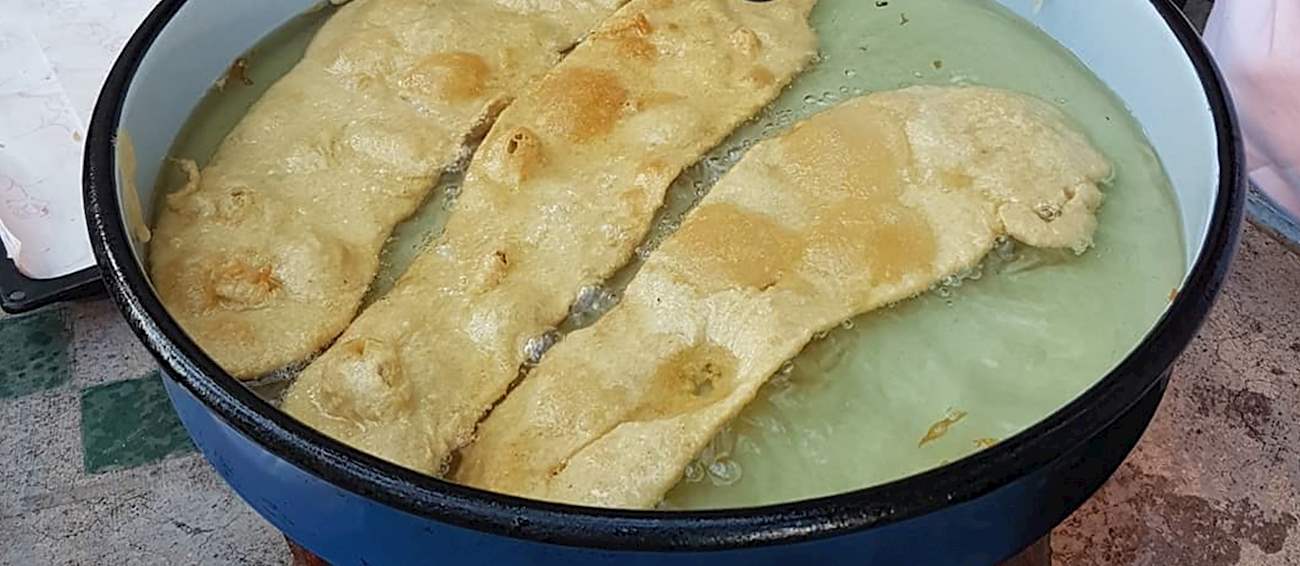Pane e olio is an Italian phrase meaning bread and oil, referring to a simple yet classic Italian dish that highlights the quality of its basic ingredients: bread and olive oil. Traditional Italian bread such as ciabatta, focaccia, or a rustic country loaf is typically used, while extra virgin olive oil (EVOO) is the oil of choice due to its superior flavor and health benefits.
High-quality, cold-pressed olive oil from regions like Tuscany or Puglia is ideal. The bread is usually sliced and may be served fresh or lightly toasted, with toasting enhancing its texture and providing a warm base for the olive oil. The olive oil is typically poured into a small dish or bowl for dipping, though some variations may include a drizzle of olive oil directly on the bread slices.
MAIN INGREDIENTS
Vrlički uštipci are traditional fritters originating from Vrlika in Croatia. The batter is made with dark flour, salt, lukewarm water, a tiny bit of local schnapps called rakija, and (optionally) an egg or two. The combination is traditionally mixed in a wooden bowl until the bubbles start to form on the surface.
The batter is then poured into hot oil or melted pork fat, and the fritters are turned over until they develop a nice golden color and a crispy exterior. When served, they can be eaten on their own, sprinkled with salt for a savory version, or accompanied by fruit jams for a sweet version.
MAIN INGREDIENTS
Krampogača is a savory Croatian biscuit or a scone with a flaky, crumbly texture. These snacks are filled with pork cracklings in order to give them more flavor. They consist of flour, pork cracklings, milk, sugar, yeast, salt, pepper, and butter or lard.
The dough is shaped into small scones, then baked until it develops a golden-brown color. Krampogača is a typical continental snack that can be found in many Croatian bakeries.
MAIN INGREDIENTS
These elongated bread rolls are a specialty of the city of Varaždin, dating back to the 18th century, when Varaždin was the capital of Croatia. They consist of flour, milk, oil, yeast, sugar, and salt. Each klipič should be at least 23cm long, and once done, four folds should be visible on the exterior.
Before baking, the dough is traditionally brushed with egg yolk and sprinkled with cumin, pumpkin, or sesame seeds. The flavor of klipiči can ebst be described as milky and slightly sour. Klipiči can be bought at numerous bakeries in Varaždin and they are commonly offered with morning coffee at most cafés in the city.
Kruh, mast i paprika is a Croatian open-faced sandwich that has been at the height of its popularity during the war in the 1990s, although it is slowly experiencing a renaissance at Croatian Christmas markets, because it is, after all, a typical winter snack.
It consists of a thick slice of bread topped with a layer of pork fat, a bit of salt, and ground red paprika. Inexpensive and extremely simple, this sandwich is often considered a poor man’s meal. However, whole generations of people have been raised on it in the 1990s.
MAIN INGREDIENTS
During the Easter holidays in Bribir, Croatia, people prepare a special dish known as bribirski prisnac. It is a savory cake consisting of eggs, flour, yeast, bacon or ham, spring onions, and a local squeaky cheese made from cow’s milk - škripavac.
Sautéed onions, bacon, and ham are combined with other ingredients, the combination is seasoned with salt and pepper, and it is then transferred into a mold and baked in the oven. When the top is golden brown, the dish is ready to be consumed.
Paški baškotin is a Croatian sweet rusk produced by Benedictine nuns in the St. Margarita monastery on the island of Pag. They have been producing it for more than 300 years. The nuns got their first oven in 1540, and they have used it since then to bake various cakes, pastries, and baškotin.
The recipe for baškotin is kept a secret. Nowadays, the nuns bake about 30 kilograms of baškotin daily, and they can’t make any more because the whole process is done by hand. Traditionally, baškotin was offered to guests with chicory coffee on the side because regular coffee was expensive and hard to come by.
MAIN INGREDIENTS
Pera is a traditional dish consisting of a thin base of leavened dough that is filled with a mixture of fresh cow’s cheese, sour cream, and eggs, with the occasional addition of cornmeal. This open-faced savory pie is one of the classic dishes found in Vrbovec, celebrated for its simplicity and the use of traditional ingredients.
Rolled into an oval shape, in the past, the dish was baked in old-fashioned wood ovens that would produce a slightly charred crust. Pera is always served sliced into triangular wedges, which is the reason why most locals refer to it as the Croatian take on Italian pizza.
MAIN INGREDIENTS
Cernički ćuptet is a savory cake or a pastry originating from the county of Cernik in Croatia, located near the city of Nova Gradiška. It is traditionally prepared during the annual pig slaughter. This delicacy is made by stuffing the dough (flour, salt, white wine, yeast, water) with a mixture of leftover sausage meat seasoned with ground paprika and garlic.
Once filled, the dough is usually shaped into squares, pinched on the sides to resemble a rose, sprinkled with melted pork fat, then baked until golden-brown. It is recommended to pair these small savory treats with a glass of local white wine and consume them as a snack.
MAIN INGREDIENTS
Once an essential element of the local diet, this fig-based treat is nowadays regarded as an authentic delicacy and the most popular souvenir of the island of Vis. It is prepared with dried figs that are mashed alongside fennel and rakija into a thick mixture.
Additional ingredients usually include almonds and sometimes various herbs, and the final product is pressed into a round, flat shape that is left to dry. Viški hib has a long shelf life, and it is traditionally preserved wrapped into rosemary or bay leaves, which are also used to provide an additional, subtle flavor.
TasteAtlas food rankings are based on the ratings of the TasteAtlas audience, with a series of mechanisms that recognize real users and that ignore bot, nationalist or local patriotic ratings, and give additional value to the ratings of users that the system recognizes as knowledgeable. TasteAtlas Rankings should not be seen as the final global conclusion about food. Their purpose is to promote excellent local foods, instill pride in traditional dishes, and arouse curiosity about dishes you haven’t tried.






